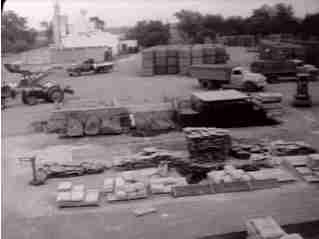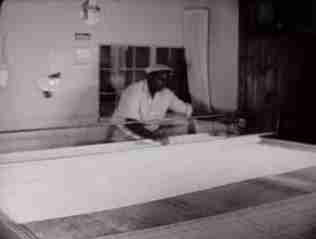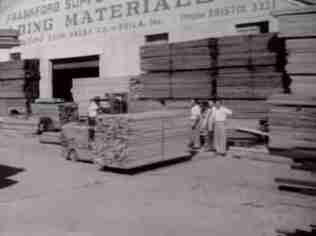 History of Pre-Cut Lumber for Rapid Building Framing
History of Pre-Cut Lumber for Rapid Building Framing
A Guide to Estimating Building Age
- POST a QUESTION or COMMENT about using pre-cut lumber, history, methods, identification, key to building age
Pre-cut wood framed construction:
This article describes and illustrates the history of use of pre-cut wood framing lumber in the development of high-speed, mass-produced housing in the United States.
Here we review the role of Levittown in development of use of pre-cut lumber for mass-produced high-speed housing in New York & Pennsylvania, 1940's, 1950's and we provide photographs of building framing lumber & lumber yards, Leavittown, PA 1954.
William Levitt created several planned communities besides Leavittown and played a key role in the development of mass-produced pre-cut platform framed homes.
InspectAPedia tolerates no conflicts of interest. We have no relationship with advertisers, products, or services discussed at this website.
- Daniel Friedman, Publisher/Editor/Author - See WHO ARE WE?
Pre-Cut Homes & Home Kit Construction - Early Mass Produced Housing
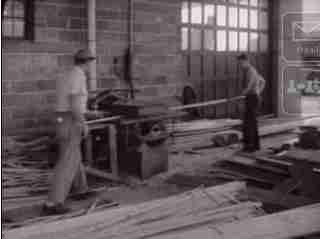 This FRAMING METHODS, AGE, TYPES article series, lists common building framing materials used in different epochs of residential construction. Knowing when certain materials were first or last in common use can help determine the age of a building.
This FRAMING METHODS, AGE, TYPES article series, lists common building framing materials used in different epochs of residential construction. Knowing when certain materials were first or last in common use can help determine the age of a building.
The age of a building can be determined quite accurately by documentation, but when documents are not readily available, visual clues such as those available during a professional home inspection can still determine when a house was built.
Original source of photographs used in this article: creative commons film: "Our Home Town: Leavittown, PA" [citation] a 1954 advertising film of Leavittown PA, one of the planned communities built by William Levitt & Sons. The first and perhaps better-known Levittown was constructed in Levittown, formed as a hamlet in the Town of Hempstead in Nassau County, Long Island, New York.
The homes, all virtually identical, were also satirized in Pete Seeger's, 1963 performance of Malvina Reynold's 1962 song "Little Boxes".
Little boxes on the hillside,
Little boxes made of ticky tacky,
Little boxes,
Little boxes,
Little boxes all the same.
There's a green one and a pink one,
And a blue one and a yellow one,
And they're all made out of ticky tacky,
And they all look just the same.
And the people in the houses all go to the university.
And they all get put in boxes, little boxes all the same - http://www.lyricsfreak.com/p/pete+seeger/little+boxes_20246431.html
OPINION: For people like the author [DF] and others born in the U.S. in the 1940's and 1950's, a 1960's satirization of conformity was familiar and one viewed with general approval. But Leavittown succeeded in providing modest, affordable homes to the emerging middle class Americans following WWII.
By the next century (2017) in an age of extreme disparity of income distribution many of our readers view the same homes with approval for their modesty and simplicity, sameness notwithstanding. In the ensuing years building owners of Levittown homes have put their own individual mark on many of the homes with modifications, expansions, and ornamentation. They're no longer identical.
It was the use of pre-cut framing and other mass-production methods that made it possible for Levitt to build such a large community rapidly and to sell these homes at low prices.
Pre-cut framing describes the use of dimensioned lumber that was pre-cut to standard lengths at the lumber yard where it was produced, then shipped to a building supplier or directly to a building site in order to speed, simplify, and reduce the cost of construction of homes.
Before dimensioned, pre-cut lumber was in widespread use on construction jobsites, lumber was often dimensioned and rough-cut, or cut to order at local lumber yards and building suppliers.
This article series describes the materials and practices used in different building framing eras: log homes, balloon framing, platform framing, arkansas framing, modular construction, panelized construction, straw bale construction, welded wire construction, trusses, engineered lumber construction.
We describe and define the different types of dimensioned lumber: full-sized and modern (smaller) framing lumber such as rafters, studs, and joists.
On the job every rafter, stud, sill-plate was either used in random lengths flat (sills) or cut to standard lengths for stud framing.
Currently at major building suppliers such as Home Depot and Loews, it would be difficult to not to find standard dimensioned lumber sold pre-cut to standard residential construction lengths.
In a "standard" wood-framed residential home, roughly 15,000 board feet of lumber is used. Site-built stick-framed homes (see Platform Framing) are constructed almost entirely of pre-cut lumber, perhaps excepting cuts necessary to frame around building openings and features.
Leavittown New York Pre-Cut Lumber Constructed Homes
According to the Leavittown Historical Society, the default of the Strathmore development project by a Rockville Centre Long Island developer in the 1930's Great Depression forced lawyer and real estate investor Abraham Levitt to take over and complete development of the project even though he and his sons were not trained in construction.
That experience led to Levitt & Sons successful bid on a Navy contract to building homes for shipyard workers in Norfolk, VA where they perfected the techniques used for high-speed, low-cost, mass production of homes built in what became Leavittown at the end of World War II.
On Long Island, in Island Trees, a golden nematode infestation that wiped out much of the area's potato crop led to farmers' selling off land in order to survive.
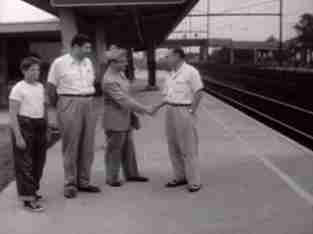
The combination of a surge in demand for housing for returning GI's from WWII, low-cost land on Long Island, and Leavitt & Son's expertise in mass-produced housing formed a perfect marriage when William Leavitt proposed to his father that the Island Trees land be divided into small lots on which could be built modest, inexpensive homes.
In May 1947 the Leavitts announced the plan to mass-produce 2000 rental homes. In two days, 1000 of the proposed homes had already been rented.
Thousands of identical wood-framed homes were built on a concrete slab on grade (no basement or crawl space), and were modest in size. According to author Gail Collins,
"In the beginning, the newly constructed dream houses were, by our current standards, very small. (In the famous Leavittown development on Long Island, the basic house was a 750-square-foot, four room Cape Cod with one bath and two bedrooms."
The following description of this early and very successful use of mass production methods to construct homes is quoted from Leavittown Historical Society:
In order to build their homes cheaper and faster, Levitt and Sons decided to eliminate basements and build their new homes on concrete slabs, as they had in Norfolk, Virginia.
This practice was prohibited in the Town Of Hempstead, but, because the need for housing was so urgent, the Town modified the Building Code to allow the Leavitts to proceed with their plan.

Levitt and Sons used many of the building methods they had used over the years in previous developments, but reorganized these methods for even better efficiency and cost savings. All of the lumber was precut and shipped from a lumber yard they owned in Blue Lake, California, where they erected a nail factory as well.
An abandoned rail line was re-opened to bring construction materials to Island Trees. To keep costs down, non-union contractors were used, a move met with heavy opposition. The production line technique used to build this new development was so successful that, by July of 1948, the Levitts were turning out thirty houses a day.
... This success continued throughout 1950 and 1951, by which time the Levitts had constructed 17,447 homes in Levittown and the immediate surrounding areas.
In 1949 the Leavitts changed from constructing rental homes to building slightly larger 800 sq. ft. ranch houses that were sold for $7,990.
These homes also were constructed on concrete slabs, but incorporated radiant slab heating.
See RADIANT HEAT.
The last of the 17,447 Leavittown homes was built in 1951.
Leavittown PA, a similar housing development was completed in the mid 1950's in Bucks County PA - the source of photos used in this article.
For a description of the role that this mass-produced housing project played in the American civil rights movement, also see Levittown: Two Families, One Tycoon... by Kushner. Quoting from part of an Amazon.com review of this text:
As shocking as the story of Levittown is, I couldn't help but ponder a message that defines the generations and races of even today: (nearly) everyone has a dream they hope to attain. Bill Levitt, in the eyes of the (white) nation and Levittown residents was living the American dream: huge house, gorgeous wives, big boat and he was (viewed as) generous.
Bill Myers and his family sought the American dream as they saw it: to own property and live freely. Levitt reflected the times of that period in America.
Yet, consider how individual groups think of their American dream today - think of it in terms of black and white - it almost makes you wonder how far we have not come. That's the one thing I really loved about this book: it made me think.
...
Continue reading at FRAMING MATERIALS, AGE, TYPES or select a topic from the closely-related articles below, or see the complete ARTICLE INDEX.
Or see these
Recommended Articles
- AGE of a BUILDING, HOW to DETERMINE - home
- ARCHITECTURE & BUILDING COMPONENT ID
- FRAMING AGE, SIZE, SPACING, TYPES
- FRAMING MATERIALS, AGE, TYPES
- FRAMING METHODS, AGE, TYPES
- KIT HOMES, Aladdin, Sears, Wards, Others
- LOG HOME GUIDE
- MODULAR CONSTRUCTION
- NAILS, AGE & HISTORY
- PANELIZED CONSTRUCTION
- PRE-CUT LUMBER CONSTRUCTION & LEAVITTOWN
- SAW & AXE CUTS, TOOL MARKS, AGE
- SAW BLADE SIZE CALCULATED from SAW MARKS
- SAW BLADE MARKS to SAW SIZE CALCULATION ICT
Suggested citation for this web page
PRE-CUT LUMBER CONSTRUCTION & LEAVITTOWN at InspectApedia.com - online encyclopedia of building & environmental inspection, testing, diagnosis, repair, & problem prevention advice.
Or see this
INDEX to RELATED ARTICLES: ARTICLE INDEX to BUILDING AGE
Or use the SEARCH BOX found below to Ask a Question or Search InspectApedia
Or see
INDEX to RELATED ARTICLES: ARTICLE INDEX to BUILDING STRUCTURES
Or use the SEARCH BOX found below to Ask a Question or Search InspectApedia
Ask a Question or Search InspectApedia
Try the search box just below, or if you prefer, post a question or comment in the Comments box below and we will respond promptly.
Search the InspectApedia website
Note: appearance of your Comment below may be delayed: if your comment contains an image, photograph, web link, or text that looks to the software as if it might be a web link, your posting will appear after it has been approved by a moderator. Apologies for the delay.
Only one image can be added per comment but you can post as many comments, and therefore images, as you like.
You will not receive a notification when a response to your question has been posted.
Please bookmark this page to make it easy for you to check back for our response.
IF above you see "Comment Form is loading comments..." then COMMENT BOX - countable.ca / bawkbox.com IS NOT WORKING.
In any case you are welcome to send an email directly to us at InspectApedia.com at editor@inspectApedia.com
We'll reply to you directly. Please help us help you by noting, in your email, the URL of the InspectApedia page where you wanted to comment.
Citations & References
In addition to any citations in the article above, a full list is available on request.
- Thanks to Eben Oldmixon for discussing half timbered framing and German fachwerk and suggesting additional website content - January 2010.
- America's Favorite Homes, mail-order catalogues as a guide to popular early 20th-century houses, Robert Schweitzer, Michael W.R. Davis, 1990, Wayne State University Press ISBN 0814320066 (may be available from Wayne State University Press)
- American Plywood Association, APA, "Portland Manufacturing Company, No. 1, a series of monographs on the history of plywood manufacturing",Plywood Pioneers Association, 31 March, 1967, www.apawood.org
- "Background on Lumber." U.S. Department of Commerce, 31 May 2004. Discusses U.S.-Canada trade disputes regarding softwood lumber. Web search 07/22/2010, original source: http://www.for.gov.bc.ca/het/softwood/abcpf%20softwood%20dispute%20section%202004%20rev.pdf
- Building Research Council, BRC, nee Small Homes Council, SHC, School of Architecture, University of Illinois at Urbana-Champaign, brc.arch.uiuc.edu. "The Small Homes Council (our original name) was organized in 1944 during the war at the request of the President of the University of Illinois to consider the role of the university in meeting the demand for housing in the United States. Soldiers would be coming home after the war and would be needing good low-cost housing.
- How could homes be designed and built more efficiently?
- What kinds of construction and production techniques worked well and which did not?
- How did people use different kinds of spaces in their homes?
- What roles did community planning, zoning, and interior design play in how neighborhoods worked?
- "Hurricane Damage to Residential Structures: Risk and Mitigation", Jon K. Ayscue,
The Johns Hopkins University, Baltimore, Maryland, published by the Natural Hazards Research and Applications Information Center, Institute of Behavioral Science, University of Colorado, November 1996. Abstract:
"Property damage and loss from hurricanes have increased with population growth in coastal areas, and climatic factors point to more frequent and intense hurricanes in the future. This paper describes potential hurricane hazards from wind and water. Damage to residential structures from three recent intense hurricanes - Hugo, Andrew, and Iniki - shows that wind is responsible for greater property loss than water. The current state-of-the-art building technology is sufficient to reduce damage from hurricanes when properly applied, and this paper discusses those building techniques that can mitigate hurricane damage and recommends measures for mitigating future hurricane damage to homes." - online at www.colorado.edu/hazards/publications/wp/wp94/wp94.html - "Evaluating OSB for Coastal Roofs," Paul Fisette, Coastal Contractor, Winter 2005, online at coastalcontractor.net/pdf/2005/0501/0501eval.pdf . Fisette cites: "Jose Mitrani, a civil engineer and professor at Florida. International University in Miami, was ... Florida’s official damage assessment team. ... After Hurricane Andrew, Florida code advisers ruled OSB sheathing inferior to plywood
- Gail Collins, When Everything Changed: The Amazing Journey of American Women from 1960 to the Present, Little, Brown, 2010, and Book review: "Growing Up Female", Cathleen Schine, The New York Review of Books, 17 December 2009, p. 8.
- Isham: "An Example of Colonial Paneling", Norman Morrison Isham, The Metropolitan Museum of Art Bulletin, Vol. 6, No. 5 (May, 1911), pp. 112-116, available by JSTOR.
- Leavittown Historical Society, PO Box 57, Leavittown, LI, NY 11756 Tel: 516-735-9060, web search 07/22/2010. Original source:
http://www.levittownhistoricalsociety.org/history.htm - Levittown: Two Families, One Tycoon, and the Fight for Civil Rights in America's Legendary Suburb, David Kushner, Walker & Company, ISBN-10: 0802716199, ISBN-13: 978-0802716194
Quoting from part of an Amazon.com review
As shocking as the story of Levittown is, I couldn't help but ponder a message that defines the generations and races of even today: (nearly) everyone has a dream they hope to attain. Bill Levitt, in the eyes of the (white) nation and Levittown residents was living the American dream: huge house, gorgeous wives, big boat and he was (viewed as) generous. Bill Myers and his family sought the American dream as they saw it: to own property and live freely. Levitt reflected the times of that period in America. Yet, consider how individual groups think of their American dream today - think of it in terms of black and white - it almost makes you wonder how far we have not come. That's the one thing I really loved about this book: it made me think. - The History of Leavittown, NY, Lynne Matarrese & the Leavittown Historical Society, available from the Leavittown Historical Society website at: http://www.levittownhistoricalsociety.org/museum_shop.htm
Quoting:
The official Levittown story, as presented by Lynne Matarrese and the Levittown Historical Society on the occasion of Levittown's 50th Anniversary. This comprehensive, illustrated volume provides general readers and serious researchers alike with a fascinating overview of Levittown's birth and development, from the earliest days of the Hempstead Plains to its modern day status as a suburban icon. - "Our Home Town: Leavittown, PA (1954), web search 07/22/2010, free download archive film, original source: http://www.archive.org/details/OurHomeT1954_2
This movie is part of the collection: Prelinger Archives, Producer: Unknown, Sponsor: Towne Theatre, Audio/Visual: Sd, B&W, Keywords: Levittown, Pa.; Philadelphia, Pa.; Suburbia, Creative Commons license: Public Domain
Advertising film presenting landmarks, businesses and people of a well-known Philadelphia suburb in Bucks County PA, one of the planned communities built by William Levitt & Sons. - OSB: "Evaluating OSB for Coastal Roofs," Paul Fisette, Coastal Contractor, Winter 2005, online at coastalcontractor.net/pdf/2005/0501/0501eval.pdf . Fisette cites: "Jose Mitrani, a civil engineer and professor at Florida. International University in Miami, was ... Florida’s official damage assessment team. ... After Hurricane Andrew, Florida code advisers ruled OSB sheathing inferior to plywood."
- Manufactured & Modular Homes: Modular Building Systems Association, MBSA, modularhousing.com, is a trade association promoting and providing links to contact modular builders in North America. Also see the Manufactured Home Owners Association, MHOAA, at www.mhoaa.us. The Manufactured Home Owners Association of America is a National Organization dedicated to the protection of the rights of all people living in Manufactured Housing in the United States.
- Pergo AB, division of Perstorp AB, is a Swedish manufacturer or modern laminate flooring products. Information about the U.S. company can be found at http://www.pergo.com where we obtained historical data used in our discussion of the age of flooring materials in buildings.
- Plank House Construction: Yuroak Plankhouse - Web: yurokplankhouse.com - plank houses were built by native Americans, see
Large 1:6 Scale Plank House Construction / P8094228, Photographer: Mike Meuser, 06/12/2007 documented at yurokplankhouse.com where scale model Museum quality Yurok Plank Houses are being sold to raise money for the Blue Creek - Ah Pah Traditional Yurok Village project -Web: bluecreekahpah.org - Radiographic Inspection of Plank-House Construction, Mary Joan Kevlin, Bulletin of the Association for Preservation Technology, Vol. 18, No. 3 (1986), pp. 40-47
- Indian houses of Puget Sound, Waterman, T. T. (Thomas Talbot) and Greiner, Ruth, Museum of the American Indian, Heye Foundation, 1921
- In addition to citations & references found in this article, see the research citations given at the end of the related articles found at our suggested
CONTINUE READING or RECOMMENDED ARTICLES.
- Carson, Dunlop & Associates Ltd., 120 Carlton Street Suite 407, Toronto ON M5A 4K2. Tel: (416) 964-9415 1-800-268-7070 Email: info@carsondunlop.com. Alan Carson is a past president of ASHI, the American Society of Home Inspectors.
Thanks to Alan Carson and Bob Dunlop, for permission for InspectAPedia to use text excerpts from The HOME REFERENCE BOOK - the Encyclopedia of Homes and to use illustrations from The ILLUSTRATED HOME .
Carson Dunlop Associates provides extensive home inspection education and report writing material. In gratitude we provide links to tsome Carson Dunlop Associates products and services.



